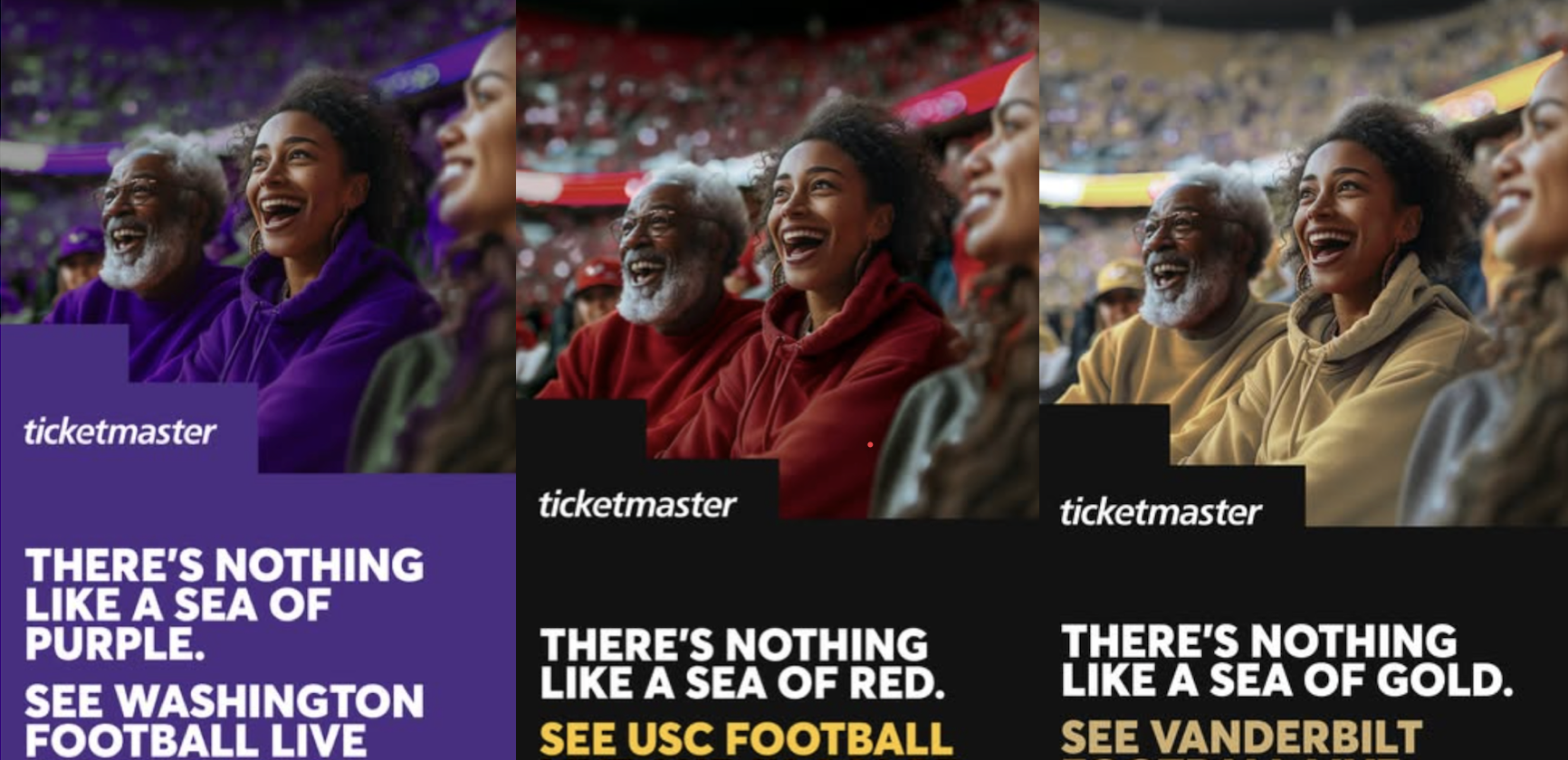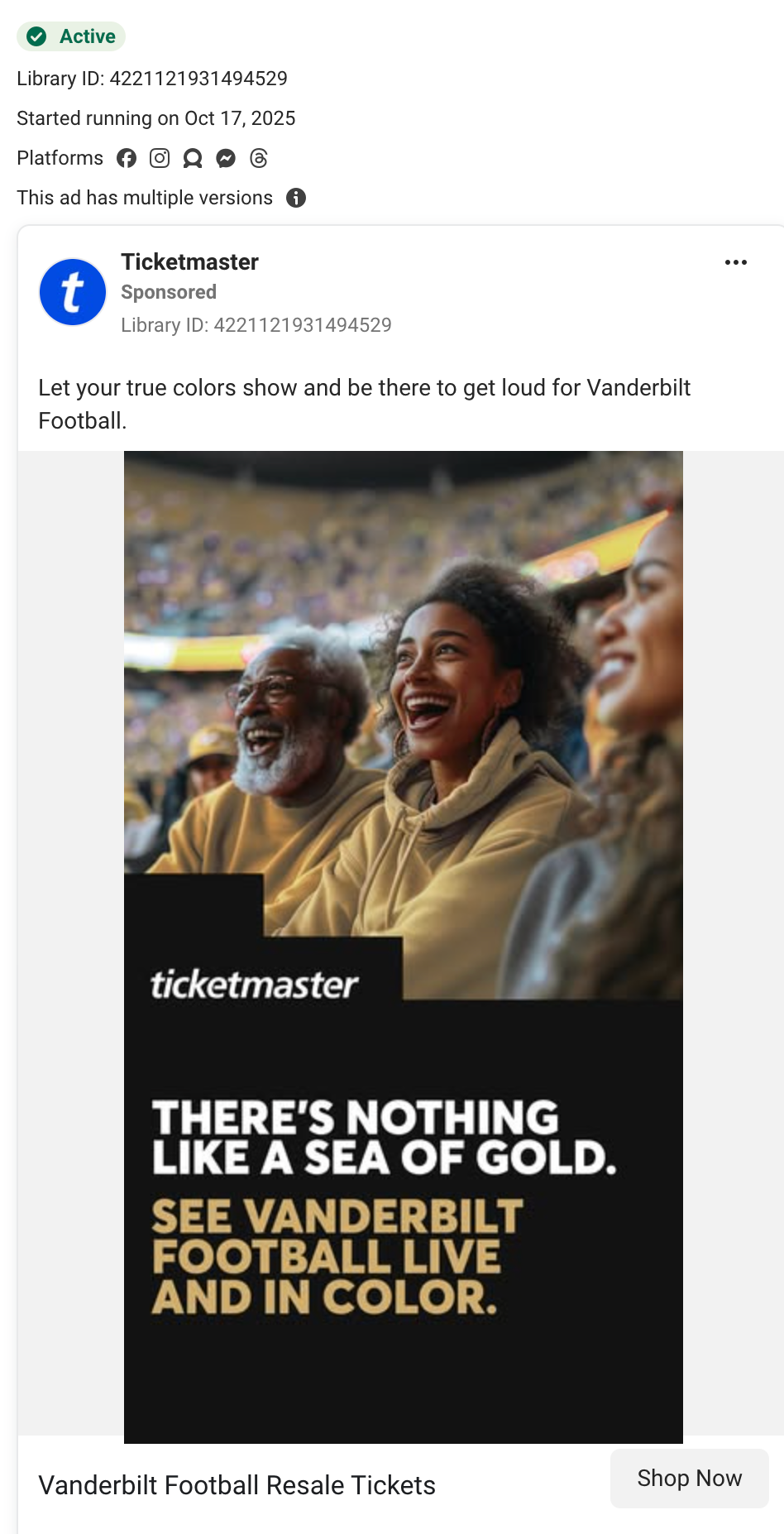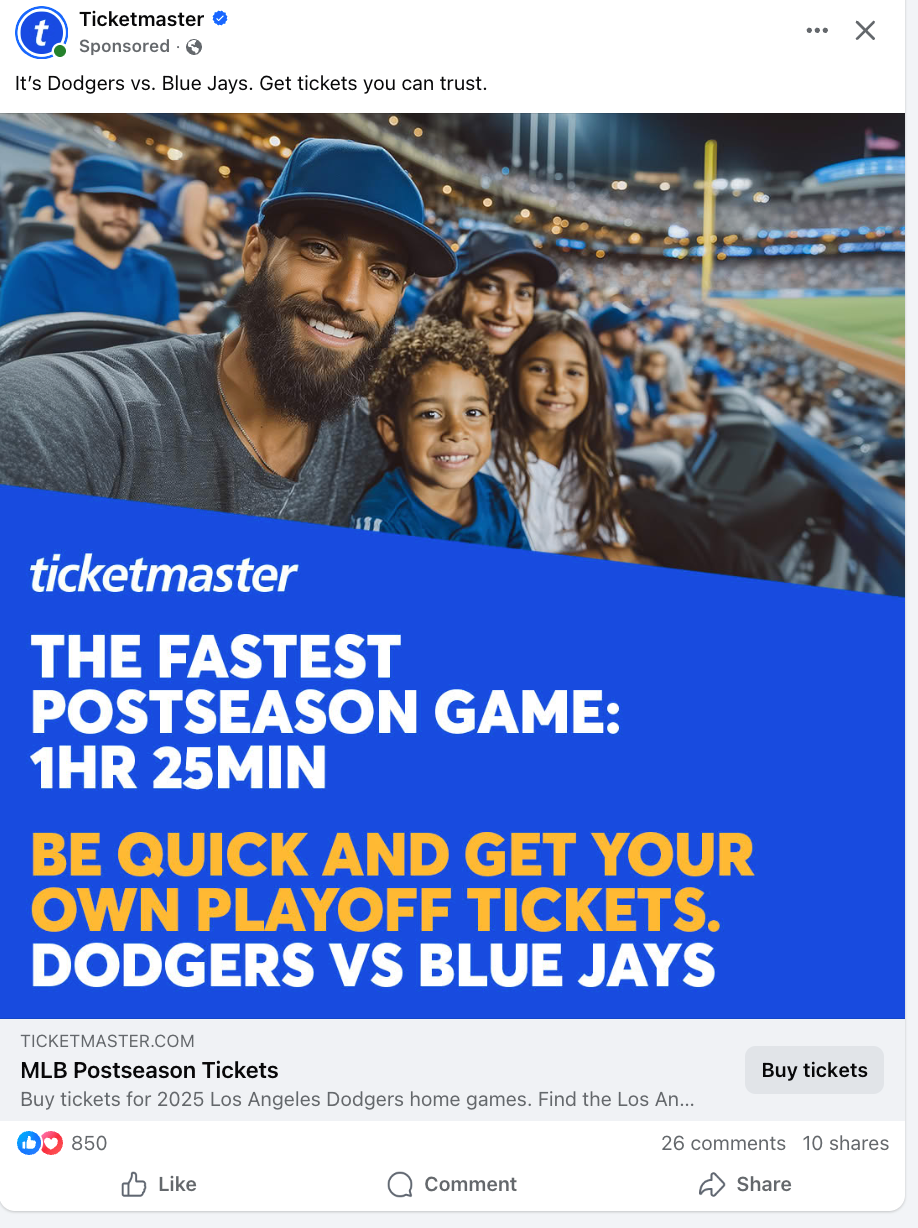
Do you and your human family have interest in sharing an exciting IRL experience supporting your [team of choice] with other human fans at The Big Game? In that case, don the chosen color of your [team of choice] and head to the local [iconic stadium]; Ticketmaster has exciting ticket deals, and soon you and your human family can look as happy and excited as these virtual avatars:







Ticketmaster’s personalized AI slop ads are a glimpse at the future of social media advertising, a harbinger of system that Mark Zuckerberg described last week in a Meta earnings call. This future is one where AI is used both for ad targeting and for ad generation; eventually ads are going to be hyperpersonalized to individual users, further siloing the social media experience: "Advertisers are increasingly just going to be able to give us a business objective and give us a credit card or bank account, and have the AI system basically figure out everything else that’s necessary, including generating video or different types of creative that might resonate with different people that are personalized in different ways, finding who the right customers are,” Zuckerberg said.
The Ticketmaster example you see above is rudimentary and crude, but everything we’ve seen over the last few months suggests that the real way Meta is bringing in revenue with AI is not through its consumer-facing products but with AI ad creation and targeting products for advertisers that allows them to create many different versions of any given ad and then to show that ad only to people it is likely to be effective on.
Ticketmaster, in this case, has has invented several virtual families whose football team allegiances change presumably based on a series of demographic, geographic, and behavioral factors that would cause you to be targeted by one of its ads. I found these ads after I was targeted by one suggesting I join this ethnically ambiguous, dead-eyed family of generic blue hat wearers at the World Series to root on, I guess, the Dodgers. I looked Ticketmaster up in Facebook’s ad library and found that it is running a series of clearly AI-generated ads, many of which use the same templates and taglines.


“There’s nothing like a sea of gold. See Vanderbilt football live and in color.” “There’s nothing like a sea of red. See USC football live and in color.” “There’s nothing like a sea of maize. See Michigan football live and in color,” and so on and so forth. There are a couple dozen of these ads for college football, and a few others that use different AI-generated people. My favorite is this one, which features the back of AI people’s heads standing and cheering at other fans and not facing where the game or field would be.

As AI slop goes, this is relatively tame fare, but it is notable that a company as big as Ticketmaster is using generative AI for its Facebook ads. It is also an instructive example that shows a big reason why Facebook and Google are bringing in so much revenue right now, and highlights the fact that social media is not so slowly being completely drowned in low-effort AI content and ads.
Here’s why you’re seeing more AI ads on social media, and why Meta and its advertising clients seem intent on making this the future of advertising.
- Generative AI creative material is cheap: The effort and cost required to make this series of ads is incredibly low. Generating something like this is easy and, at most, requires just a small amount of human prompting and touchup after it is generated. But most importantly, Ticketmaster doesn’t have to worry about paying human models or photographers, does not have to worry about licensing stock photos, and, notably, there are no logos or actual places highlighted in any of these ads. There are no players, no teams, just the evocation of such. There is no need to get permission from or pay for logo licensing (this reminds me of a Wheaties box of Cal Ripken that I got as a kid in the immediate aftermath of him breaking the 2131 consecutive games record. In the boxes released immediately, he was wearing only a black t-shirt and a black helmet. A few days later, after General Mills presumably secured the rights to use Orioles logos, they started selling the same box with his Orioles jersey and helmet on them).
- Less money on creative means more budget for spend, and more varieties of ads: I’ve written about this before, but a big trend in advertising right now is AI-powered ad creative trial and error. Using AI, it is now possible to make an essentially endless number of different variations of a single ad that uses slightly different language, slightly different images, slightly different calls to actions, and different links. AI targeting also means that “successful” variations of ads will essentially automatically find the audience that they’re supposed to. This means that companies can just flood social media with zillions of variations of low-effort AI ads, put their “spend” (their ad budget) into the versions that perform best, and let the targeting algorithms do the rest. AI in this case is a scaling tactic. There is no need to spend tons of time, money, and human resources refining ad copy and designing thoughtful, clever, funny, charming, or eye-catching ads. You can simply publish tons of different versions of low-effort bullshit, and largely people will only see the ones that perform well.
- This is Meta’s business model now: Meta’s user-facing commercial generative AI tools are pretty embarrassing and in my limited experience its chatbot and image and video generation tools are more rudimentary than OpenAI’s, Google’s, and other popular AI companies’ tools. There is nothing to suggest that Meta is making any real progress on Mark Zuckerberg’s apparent goal of “superintelligence.” But its AI and machine learning-powered ad targeting and ad variation tools seem to be very successful and are resulting in companies spending way more money on ads, many of which look terrible to me but which are apparently quite successful. Meta announced its third quarter earnings on Wednesday, and in its earnings call, it highlighted both Advantage+ and Andromeda, two AI advertising products that do what I described in the bullet above.
Advantage+ is its advertiser-facing AI ad optimization platform which lets advertisers optimize targeting, but also lets them use generative AI to create a bunch of variations of ads: “Advantage+ creative generates ad variations so they are personalized to each individual viewer in your audience, based on what each person might respond to,” the company advertises.
“Within our Advantage+ creative suite, the number of advertisers using at least one of our video generation features was up 20% versus the prior quarter as adoption of image animation and video expansion continues to scale. We’ve also added more generative AI features to make it easier for advertisers to optimize their ad creatives and drive increased performance. In Q3, we introduced AI-generated music so advertisers can have music generated for their ad that aligns with the tone and message of the creative,” Meta said in its third quarter earnings report.
Susan Li, Meta’s CFO, said “now advertisers running sales, app or lead campaigns have end-to-end automation turned on from the beginning, allowing our systems to look across our platform to optimize performance by automatically choosing criteria like who to show the ads to and where to show them.”
Andromeda, meanwhile, is designed to “supercharge Advantage+ automation with the next-gen personalized ads retrieval engine.” It is basically a machine learning-powered ad targeting tool, which helps the platform determine which ad, and which variation of an ad, to show a specific user: “Andromeda significantly enhances Meta’s ads system by enabling the integration of AI that optimizes and improves personalization capabilities at the retrieval stage and improves return on ad spend,” the company explains.
This is all going toward a place where Meta itself is delivering hyper personalized, generative AI slop ads for each individual user. In the Meta earnings call, Mark Zuckerberg described exactly this future: “Advertisers are increasingly just going to be able to give us a business objective and give us a credit card or bank account, and have the AI system basically figure out everything else that’s necessary, including generating video or different types of creative that might resonate with different people that are personalized in different ways, finding who the right customers are.”
I don’t know if Ticketmaster used Advantage+ for this ad campaign, or if this ad campaign is successful (Ticketmaster did not respond to a request for comment). But the tactics being deployed here are an early version of what Zuckerberg is describing, and what is obviously happening to social media right now.
From 404 Media via this RSS feed


